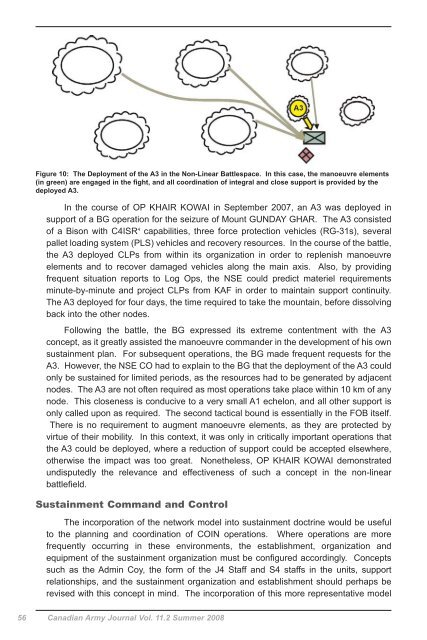Practical Sustainment Concepts for the Non-Linear Battlespace
Practical Sustainment Concepts for the Non-Linear Battlespace
Practical Sustainment Concepts for the Non-Linear Battlespace
Create successful ePaper yourself
Turn your PDF publications into a flip-book with our unique Google optimized e-Paper software.
Figure 10: The Deployment of <strong>the</strong> A3 in <strong>the</strong> <strong>Non</strong>-<strong>Linear</strong> <strong>Battlespace</strong>. In this case, <strong>the</strong> manoeuvre elements<br />
(in green) are engaged in <strong>the</strong> fight, and all coordination of integral and close support is provided by <strong>the</strong><br />
deployed A3.<br />
In <strong>the</strong> course of OP KHAIR KOWAI in September 2007, an A3 was deployed in<br />
support of a BG operation <strong>for</strong> <strong>the</strong> seizure of Mount GUNDAY GHAR. The A3 consisted<br />
of a Bison with C4ISR4 capabilities, three <strong>for</strong>ce protection vehicles (RG-31s), several<br />
pallet loading system (PLS) vehicles and recovery resources. In <strong>the</strong> course of <strong>the</strong> battle,<br />
<strong>the</strong> A3 deployed CLPs from within its organization in order to replenish manoeuvre<br />
elements and to recover damaged vehicles along <strong>the</strong> main axis. Also, by providing<br />
frequent situation reports to Log Ops, <strong>the</strong> NSE could predict materiel requirements<br />
minute-by-minute and project CLPs from KAF in order to maintain support continuity.<br />
The A3 deployed <strong>for</strong> four days, <strong>the</strong> time required to take <strong>the</strong> mountain, be<strong>for</strong>e dissolving<br />
back into <strong>the</strong> o<strong>the</strong>r nodes.<br />
Following <strong>the</strong> battle, <strong>the</strong> BG expressed its extreme contentment with <strong>the</strong> A3<br />
concept, as it greatly assisted <strong>the</strong> manoeuvre commander in <strong>the</strong> development of his own<br />
sustainment plan. For subsequent operations, <strong>the</strong> BG made frequent requests <strong>for</strong> <strong>the</strong><br />
A3. However, <strong>the</strong> NSE CO had to explain to <strong>the</strong> BG that <strong>the</strong> deployment of <strong>the</strong> A3 could<br />
only be sustained <strong>for</strong> limited periods, as <strong>the</strong> resources had to be generated by adjacent<br />
nodes. The A3 are not often required as most operations take place within 10 km of any<br />
node. This closeness is conducive to a very small A1 echelon, and all o<strong>the</strong>r support is<br />
only called upon as required. The second tactical bound is essentially in <strong>the</strong> FOB itself.<br />
There is no requirement to augment manoeuvre elements, as <strong>the</strong>y are protected by<br />
virtue of <strong>the</strong>ir mobility. In this context, it was only in critically important operations that<br />
<strong>the</strong> A3 could be deployed, where a reduction of support could be accepted elsewhere,<br />
o<strong>the</strong>rwise <strong>the</strong> impact was too great. <strong>Non</strong>e<strong>the</strong>less, OP KHAIR KOWAI demonstrated<br />
undisputedly <strong>the</strong> relevance and effectiveness of such a concept in <strong>the</strong> non-linear<br />
battlefield.<br />
<strong>Sustainment</strong> Command and Control<br />
The incorporation of <strong>the</strong> network model into sustainment doctrine would be useful<br />
to <strong>the</strong> planning and coordination of COIN operations. Where operations are more<br />
frequently occurring in <strong>the</strong>se environments, <strong>the</strong> establishment, organization and<br />
equipment of <strong>the</strong> sustainment organization must be configured accordingly. <strong>Concepts</strong><br />
such as <strong>the</strong> Admin Coy, <strong>the</strong> <strong>for</strong>m of <strong>the</strong> J4 Staff and S4 staffs in <strong>the</strong> units, support<br />
relationships, and <strong>the</strong> sustainment organization and establishment should perhaps be<br />
revised with this concept in mind. The incorporation of this more representative model<br />
56 Canadian Army Journal Vol. 11.2 Summer 2008







![La modularite dans l'Armee de terre canadienne [pdf 1.6 MB]](https://img.yumpu.com/17197737/1/188x260/la-modularite-dans-larmee-de-terre-canadienne-pdf-16-mb.jpg?quality=85)









